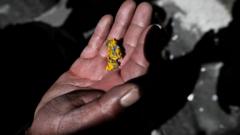Thirteen miners have tragically been discovered dead in a gold mine in Peru after being kidnapped several days beforehand. The victims were working at a site owned by Poderosa, a mining company located in Pataz province, north of Lima. Their kidnapping occurred as they were dispatched to confront illegal miners, but they were captured by a criminal gang aiming to seize control of the mine.
These miners were held hostage in an underground shaft, with their captors sending distressing messages to the families over the course of a week. The alarming rise in attacks against mining operations has been observed across Peru in recent years.
In a statement released by Poderosa, which employs around 8,000 individuals, the company expressed disappointment regarding the insufficient police action in combating illegal mining activities. "The climate of violence continues to escalate in the region," the statement emphasized. Reports have surfaced, including one from Diario Correo, of a video circulated on social media in which the captors allegedly show the execution of the miners at point-blank range.
The motives behind the execution remain unclear. Since 2020, illegal mining operations have overtaken numerous mines administered by Poderosa, compelling the company to close several sites and jeopardizing both workers and artisanal miners.
In a related incident earlier this year, gang members collaborating with illegal miners attacked contractors at the La Ciénaga ravine, resulting in two fatalities. Furthermore, the company faced bomb threats to critical infrastructure, including a high-voltage power tower, while illegal miners attempted to encroach on various sites.
Poderosa has expressed its concerns about the incapacity of police and military forces to regain control over the situation, urging government officials to take action and restore order. The rampant illegal mining and organized crime are reportedly functioning with "absolute impunity." Peru ranks among the world's largest gold producers, contributing more than 100 tonnes annually, which amounts to approximately 4% of the global supply.


















